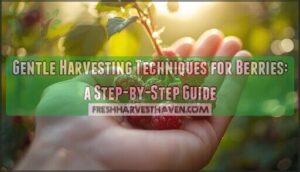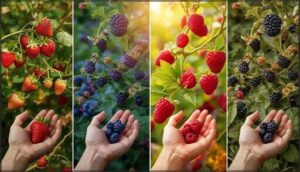This site is supported by our readers. We may earn a commission, at no cost to you, if you purchase through links.
A single raspberry contains over 100 individual drupelets, each one a tiny water balloon waiting to burst at the slightest squeeze. That’s the challenge every berry picker faces—you’re handling fruit that bruises faster than a ripe peach and starts deteriorating the moment it leaves the plant.
Most home gardeners lose up to a third of their harvest to damage that happens right at the picking stage, not in storage. The difference between a bowl of picture-perfect berries and a mushy disappointment comes down to your hands.
Mastering gentle harvesting techniques for berries transforms your yield from fragile to superb, starting with understanding exactly how each variety wants to be handled.
Table Of Contents
Key Takeaways
- Berries bruise easily due to their thin skins, soft flesh, and 85-92% water content, with cell walls rupturing at forces as low as 0.16 Newtons, making gentle handling essential from the moment you touch them until they’re stored.
- Proper harvest timing depends on reading color changes, surface gloss, and firmness—each berry type has its own seasonal window that can shift 2-3 weeks yearly based on weather, so you’ll need to monitor ripeness indicators rather than relying solely on calendar dates.
- The right tools and techniques prevent up to 35% of bruising damage: use soft-lined containers, sharp sterilized shears, and hand-picking methods specific to each berry variety, while keeping containers filled to only 80% capacity in single layers.
- Rapid cooling within 60 minutes of harvest to 32-35°F preserves shelf life dramatically—every hour at field temperature costs you a full day of freshness, and single-layer storage with breathable packaging can extend quality by 2.5 times compared to conventional methods.
Why Berries Require Gentle Harvesting
Berries aren’t like apples or oranges that can handle a bit of rough treatment. Their delicate build makes them vulnerable to damage at every stage of harvest, from the moment you touch them to when they land in your basket.
Understanding why they bruise so easily will help you handle them with the care they need.
Fragile Structures and High Water Content
Understanding fragility is the first step to protecting your harvest. Berries have thin skins, soft flesh, and high water content—usually 85–92% by weight—that make them prime candidates for spoilage risk. Their delicate cell walls rupture at surprisingly low harvest force, sometimes just 0.16 Newtons.
Berries bruise easily because their thin skins, soft flesh, and high water content make them incredibly fragile at harvest
Gentle harvesting of delicate berries minimizes cellular damage and aids smart water management, especially as environmental impacts like rainfall and drought shift berry structure. Excess moisture further accelerates this spoilage process.
- Thin outer skins tear easily
- Soft inner flesh bruises quickly
- High water content accelerates decay
- Weak cell walls collapse under pressure
- Temperature swings increase fragility
Common Delicate Berry Varieties
Each berry variety presents its own handling challenge. Strawberry cultivars like Sparkle show extreme strawberry softness with paper-thin skins. Blueberry skins on highbush varieties tear easily despite their commercial popularity across 102,400 U.S. acres. Raspberry structure features hollow centers that collapse under pressure, while blackberry damage occurs rapidly after picking.
Asia is believed to be the birthplace of raspberries, making gentle harvesting of delicate berries more critical than ever. Arctic decline now threatens cloudberries, making gentle harvesting of delicate berries more critical than ever.
Impact of Rough Handling on Berry Quality
Rough picking triggers multiple forms of fruit damage. Bruising and decay spread quickly—studies show 20–50% quality loss across supply chains when berries face careless handling.
You’ll notice firmness and texture deteriorate as cells rupture, while color degradation creates brown spots that lower market value. Microbial contamination enters through damaged skin, shortening shelf life to just days.
The economic consequences hit hard: minimizing berry damage protects both your harvest and income.
Identifying and Picking Ripe Berries
Knowing when to pick your berries makes all the difference between bland fruit and peak flavor. You’ll need to read a few simple signs—color changes, firmness, and even smell—to determine the perfect harvest moment.
Let’s walk through what to look for so you can time your picking just right.
Visual and Tactile Ripeness Indicators
A ripe berry tells its story in color and feel—you just need to know where to look. Watch for these four signs of berry ripeness:
- Color Changes: Berries shift from green to vibrant hues as anthocyanins accumulate, with darker tones signaling peak berry sweetness
- Surface Gloss: A shiny, smooth skin indicates freshness and proper hydration
- Hand-Feel: Gentle pressure reveals firm yet yielding textures—not mushy or rock-hard
- Berry Flavor Indicators: High Soluble Solids (measured as °Brix) mean better taste, though opto-tactile sensing technology now helps growers assess ripeness without damaging delicate fruit
Seasonal Timing for Different Berry Types
Timing your harvest right means sweeter fruit and less waste. Each berry type follows its own clock, shaped by Climate Zone Impact and local cultivar harvest dates:
| Berry Type | Peak Harvest Season | Regional Harvest Variations |
|---|---|---|
| Strawberries | April–June | Texas/Florida (April); Northern states (June) |
| Blueberries | April–September | Southern zones (April–June); Northern zones (July–September) |
| Raspberries | June–October | Early cultivars (July); Late varieties (August–October) |
| Blackberries | April–July | Florida (April–May); Pacific Northwest (June–July) |
| Cranberries | September–November | Off-Season Supply from Chile (March–May) |
Weather Condition Effects shift harvest timing 2–3 weeks yearly, so monitor your berry ripeness indicators alongside these berry seasonality windows for best harvest timing across different berry types.
Best Weather Conditions for Harvest
When you’re planning your harvest, weather matters more than you might think. Pick during early morning hours on dry days—temperatures between 15–25°C keep berries firm and flavorful. Avoid windy conditions exceeding 20 mph, which can bruise fruit and increase moisture loss.
South-facing slopes and extended daylight exposure boost sugar content, so factor slope orientation and microclimate management into your harvest timing strategy.
Essential Tools and Protective Gear
You don’t need fancy equipment to harvest berries gently, but the right tools make a real difference.
A few simple items protect both you and the fruit from damage while making the work easier on your hands and back.
Let’s look at what you should have in your berry-picking toolkit.
Soft-Lined Containers and Breathable Baskets
Think of soft-lined containers as protective cradles for your harvest. These cushioned baskets cut bruising by up to 35%, while breathable designs slash spoilage by 28%. You’ll boost transport efficiency and extend shelf life by three to five days.
Choose shallow container selection with ventilation—foam or pulp liners work beautifully for the gentle harvesting of delicate berries.
This smart packaging for delicate fruits also aligns with sustainability trends consumers value.
Sharp Shears and Ergonomic Tools
Sharp shears transform your harvest by cutting berry damage by 15–20% compared to bare hands. Properly maintained harvesting tools deliver clean cuts that preserve fruit tissues and extend shelf life. Ergonomic design matters—these harvesting equipment innovations reduce hand-arm vibration by 61% and muscle strain by 20%.
- Shear efficiency: Straight blades for general picking, curved for delicate bunches
- Injury reduction: Spring-mounted, adjustable grips match your grip perfectly
- Tool maintenance: Regular sharpening, oiling, and sterilization practices prevent disease spread
Gloves and Clothing for Safe Foraging
Your hands and skin take the brunt of the harvest, so protective equipment isn’t optional—it’s essential for foraging safety. Nitrile gloves earn top glove material ratings for hygiene allergen mitigation, while leather-palm gauntlets cut insect thorn injuries by 70%.
Long sleeves and trousers prevent dermatitis skin injuries from plant contact, which causes 50% of agricultural skin disease. Protective clothing reduces clothing hazard reduction risks, and a basic firstaid kit addresses allergic reactions.
Tool Sterilization for Disease Prevention
Clean harvesting tools can make or break your berry crop. Pathogen transmission from contaminated fruit picking tools spreads disease to healthy plants fast. Here are recommended sanitizers for effective sterilization methods:
- 3.5% sodium hypochlorite (household bleach)
- Boiling water for 60+ seconds
- Acidified sodium chlorite at 0.02%
- Soap wash with sun-drying
- Physical scrubbing before chemical treatment
Sterilization prevalence among growers sits around 90%, and strict plant care routines reduce disease outbreaks considerably. The economic impact? Proper harvesting techniques can cut fruit rejection rates by 25%.
Step-by-Step Gentle Harvesting Techniques
Now that you’ve got your tools ready, it’s time to put them to work. The way you actually pick and handle berries makes all the difference between a basket of perfect fruit and a mushy mess.
Here’s how to approach each step of the harvest with care.
Hand-Picking Methods for Each Berry Type
Each berry variety calls for its own handpicking techniques. For strawberries, grasp the stem and pull gently—never squeeze the fruit. When berry picking blueberries, roll them between your thumb and forefinger for clean berry detachment.
Raspberries release easily when ripe, so ripeness selection matters for picker efficiency. With blackberries, use three fingers and a gentle touch to minimize damage.
Proper harvest timing and these gentle touch techniques keep your harvesting techniques effective across all berry varieties.
Using Grabbing Tools Without Causing Damage
While hand-picking works beautifully, grabbing tools can boost your harvest efficiency when you choose the right ones. Look for gentle gripping mechanisms made from soft materials like silicone-coated tines—these reduce fruit damage considerably.
Here’s what matters most for berry harvesting success:
- Force calibration keeps pressure under 0.35 Newtons to prevent tearing
- Ergonomic design reduces hand strain during long sessions
- Tool sterilization between uses cuts contamination by over 50%
User training also plays a role—tilting tools upward while pulling gently can reduce berry bruising by 22%.
Preventing Bruising During Collection
Once you’ve picked your berries, bruise prevention becomes your next priority. Gentle berry harvesting means using soft container liners—bubble liners alone can reduce fruit damage by 20%. Individual berry spacing matters too, since single-layer placement cuts bruising by 42% compared to piling berries together.
Minimize berry movement by keeping controlled drop heights under 1.2 meters. Ergonomic tool design and careful berry handling protect your harvest’s quality from field to storage.
Managing Harvest Load and Container Filling
Your container fill levels matter just as much as your picking technique. Overfilling consequences are real—containers packed beyond 80-90% capacity show up to 30% more bruising.
For efficient berry harvesting, follow these load distribution methods:
- Keep berries in single layers for single-layer benefits that preserve 95% of firmness
- Choose ventilated containers—container material impact affects temperature by up to 3°C
- Tilt rather than pour when transferring
- Fill to 80% maximum capacity
These gentle berry harvesting and berry handling practices make your harvesting methods and berry harvesting techniques truly effective.
Post-Harvest Handling and Storage Tips
You’ve picked your berries with care, but the work isn’t over yet. How you handle them in the next few hours makes all the difference between fruit that lasts and fruit that turns to mush.
Here’s what you need to know about keeping your harvest in top shape.
Immediate Cooling and Refrigeration
Every hour your berries sit at field temperature can steal a full day of shelf life. That’s why rapid cooling within 60 minutes is essential for spoilage reduction.
Aim for postharvest cooling and storage at 32–35°F to preserve berry quality and firmness. Proper temperature control protects quality attributes you worked hard to grow, preventing the economic losses that poor berry storage causes worldwide.
Sorting, Cleaning, and Single-Layer Storage
Once rapid cooling is complete, your postharvest care continues with cleaning and sorting berries. Defect removal matters—sorting lines can catch up to 90% of unmarketable fruit before berry storage begins.
For washing efficacy, rinse under cold water for one minute:
- Remove surface contaminants without soaking
- Dry immediately to maintain berry quality
- Arrange in single layers to prevent crushing
Storage comparison studies show single-layer methods reduce damage by 18–22%. This commercial practice also improves microbial quality by allowing airflow around each berry.
Breathable Packaging for Transport
Beyond cooling methods, your packaging choices directly shape fruit freshness during transport. Film innovations like micro-perforated materials maintain ideal oxygen levels, extending shelf life up to 2.5 times longer than conventional options.
For packaging for delicate fruits, moisture control matters—specialized films preserve 82–92% of berry weight over 30 days. These MAP benefits translate to real export outcomes, with spoilage rates dropping 12–18%. Smart fruit storage starts here.
Short- and Long-Term Preservation Methods
What if you could enjoy your harvest months from now? Smart storage solutions make it possible. Freezing techniques preserve up to 95% of vitamin C after six months. Drying methods extend shelf life, though you’ll lose some anthocyanins. For jam preparation, expect 60–70% vitamin retention.
Novel preservation approaches like microencapsulation boost nutritional retention even further. These berry preservation techniques and fruit storage methods keep your bounty fresh year-round.
Frequently Asked Questions (FAQs)
How do I harvest berries in the rain?
Rain is like an unwelcome guest at harvest—it invites mold and berry spoilage. Avoid harvesting berries wet when possible.
Rain harvesting risks include splitting, disease, and economic impacts that can reduce shelf life by 30%.
Can berries be picked when slightly underripe?
You can pick berries slightly underripe, but they won’t ripen further or sweeten after harvest.
Determining berry ripeness matters—underripe fruit stays tart, impacts flavor quality, and reduces shelf life compared to fully ripe picks.
What causes uneven ripening in berry patches?
Think of a field as a patchwork quilt—each square tells a different story. Microclimate effects, pollination issues, nutrient imbalances, weather extremes, and plant vigor all shape berry ripening, creating uneven fruit maturation across your patch.
How do I manage pests during harvest season?
Monitor pests with traps weekly, use fine-mesh netting before peak harvest, and time organic treatments to pest cycles.
Early action protects plant health and crop yield while minimizing damage effects on berry quality.
Should I wash berries immediately after picking?
Like a delicate fabric that frays when wet, freshly picked berries lose their natural protection once washed. Skip immediate washing—it introduces moisture that accelerates spoilage risks and reduces shelf life, compromising fruit quality during storage.
Conclusion
The proof is in the pudding—your harvest quality depends entirely on how you treat each berry from branch to basket. Gentle harvesting techniques for berries aren’t optional refinements; they’re the foundation of preserving what you’ve grown.
When you pick with intention, cool immediately, and store thoughtfully, you’re protecting months of cultivation in those final critical moments. Your careful hands determine whether those drupelets reach the table intact or turn to mush before breakfast.
- https://survivalbite.com/shtf-survival-plan-essential-strategies-for-preparedness/
- https://x.com/SurvivalBiteX
- https://limitsofstrategy.com/a-step-by-step-approach-to-cultivating-organic-raspberries/
- https://italianberry.it/en/news/pre-harvest-and-post-harvest-practices-berry-crops-hidden-costs-being-close-market
- https://smallfruits.org/2022/01/develop-soft-robotic-gripper-for-robotic-harvesting/










